Fabergé egg
A Fabergé egg is one of the jewelled eggs made by Peter Carl Fabergé and his company between 1885 and 1917.[1]
The most famous are those made for the Russian Tsars Alexander III and Nicholas II. They were Easter gifts for their wives and mothers, and are called the 'Imperial' Fabergé eggs. The House of Fabergé made about 52 imperial eggs, of which 46 have survived.[2] Two more were planned for Easter 1918, but were not delivered, due to the Russian Revolution.[3]
List of Fabergé Tsar Imperial Easter eggs
Below is a list of the eggs made for the Russian imperial family.[4]
| Date | Egg | Image | Description | Owner |
|---|---|---|---|---|
| 1885 | First Hen Egg |  |
Also known as the Jewelled Hen Egg, it was the first in a series of 54 jeweled eggs made for the Russian Imperial family under Peter Carl Fabergé's supervision. The tsarina and the tsar enjoyed the egg so much that Alexander III ordered a new egg from Fabergé for his wife every Easter | Viktor Vekselberg Viktor Vekselberg - Wikipedia |
| 1886 | Jewelry Easter “Lapis lazuli” egg | Made of lapis lazuli , enameled with gold, blue, white and yellow enamel , decorated with pearls , rubies and diamonds. The yolk of the jewelry egg contains a miniature imperial crown and a ruby pendant. According to the well-known agreement between the Emperor of Russia and Carl Fabergé that not a single Easter egg from the imperial series could be repeated, a lapis lazuli egg, despite the presence of a surprise crown, cannot be imperial. Perhaps it was intended for or belonged to one of the members of the imperial family. In addition, the jewelry Easter egg “ Check Kelkh ”, made in 1898 by Mikhail Perkhin for Varvara Kelkh, practically copies the lapis lazuli egg (1886) | Cleveland Museum of Art | |
| 1886 | Hen egg with sapphire pendant |   |
Also known as the Egg with hen in basket, it was made in 1886 for Alexander III, who presented it to his wife, the Empress Maria Feodorovna {possibly the Faberge Egg is in this 1902 photograph); the picture shown here is the 1898 jewelry Easter egg “ Check Kelkh ”,for Varvara Kelkh, | LOST |
| 1887 | Third Imperial Egg |  |
A jewelled and ridged yellow gold egg with Vacheron & Constantin watch. It is on its original tripod pedestal. In 2014, it was bought by London-based jeweler Wartski on behalf of a private collector.[5] | Private Collection |
| 1888 | Cherub with chariot Egg |   |
Also known as the Angel with egg in chariot, made and delivered in 1888 to Alexander III. This is one of the lost Imperial eggs. Few details are known about The surprise in the egg is a cherub with a clock. | LOST |
| 1889 | Nécessaire Egg |  |
Crafted and delivered to Alexander III, who presented it to his wife, Maria Feodorovna, on Easter 1889. | LOST |
| 1890 | Danish palaces Egg |  |
Crafted and delivered to Alexander III, who presented it to his wife, Maria Feodorovna, on Easter 1890. Egg decorated with pink and purple enamel. Divided into 12 sections by rose cut diamonds . The intersections and top are decorated with embossed leaves. Inside there is a surprise - a miniature screen in the form of 10 watercolor paintings-panels on mother-of-pearl with views of palaces in Denmark and Russia.s | Matilda Geddings Gray Foundation.[6] |
| 1891 | Memory of Azov Egg |  |
The Surprise is the warship "Memory of Azov"on which Tsarevich Nikolai Alexandrovich and his brother Georgy Alexandrovich sailed to the Far East in 1890-1891. Jewelers: Mikhail Perkhin and Yuri Nikolay. Rococo style . | Kremlin Armoury, Moscow, Russia |
| 1892 | Diamond trellis Egg |   |
Bavenite egg, decorated with platinum mesh and diamonds. A jadeite stand (lost) in the form of three cherubs holding an egg (representing the sons of Emperor Alexander III: heir Nicholas, George and Michael).The surprise, an elephant automaton thought to have been lost for many years, was identified in 2015 as being in the collection of the British Royal Collection Trust | Private collection |
| 1893 | Caucasus Egg |  |
The egg on a gold stand (imitates bent wood) has 4 opening windows, and on the doors there are numbers that form the year of presentation (1893). In the windows are miniatures of places in the Caucasus where the Empress’s son, Grand Duke Georgy Alexandrovich, lived.It is believed that watercolor miniatures are a surprise. | Matilda Geddings Gray Foundation.Displayed in the Metropolitan Museum of Art in New York City, New York. |
| 1894 | Renaissance Egg |   |
The jeweler, Mikhail Perkhin , used Le Roy’s casket (17th century), stored in the “ Green Vaults ” in Dresden , Faberge’s homeland, as a basis. The surprise is unknown, perhaps a crystal Resurrection egg or pearl jewelry. One theory is that the surprise is another Fabergé egg, the Resurrection, which perfectly fits the curvature of the Renaissance egg's shell and has a similar decoration in enamel on the base. | Viktor Vekselberg |
| 1895 | Rosebud Egg |  |
The first egg given to Alexandra Fedorovna. Neoclassical style . The surprise is a yellow rose (in memory of Darmstadt , the empress’s homeland, which was proud of its flowers). Inside the flower is a crown, inside of which is a pendant (lost). | Viktor Vekselberg |
| 1895 | Blue serpent clock Egg |  |
Clock egg made in the tradition of Sevres porcelain . Surprise - a working clock mechanism. The motionless snake serves as the hour hand. Ordered in 1894 by Alexander III as a gift to his wife, Maria Feodorovna ; after his imminent death, it was presented to Maria Feodorovna for Easter 1895 by her son Nicholas II . Before March 2014 mistaken for the Third Imperial Egg | Albert II of Monaco collection, Monte-Carlo, Monaco |
| 1896 | Rock crystal Egg |  |
Also known as the revolving miniatures egg.A rock crystal egg topped with a large Siberian emerald on a gold and crystal pedestal. Surprise - 12 miniatures on a golden axis with views of places memorable for the Empress. Clicking on the emerald causes the miniatures to move. | Virginia Museum of Fine Arts |
| 1896 | Twelve monograms Egg | 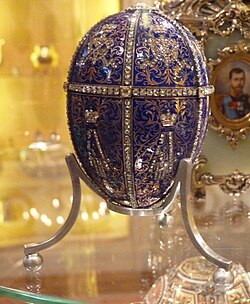 |
Also known as the Alexander III portraits egg.Jeweler - Mikhail Perkhin . The egg was ordered by the new emperor for his mother. The initials MF and AIII ( Maria Fedorovna and Alexander III ) are applied to the enamel , repeated 6 times and encrusted with diamonds.The surprise is lost. Probably contained 6 portrait miniatures of the emperor.[7] | Hillwood Museum, Washington D.C. |
| 1897 | Imperial Coronation Egg |  |
The most famous of the "Imperial" eggs.Surprise - an exact 10-centimeter copy of the Imperial carriage of Catherine II for the coronation of Nicholas II . The door opens and the footrest folds down. Mini-surprises were lost: a stand made of jadeite and silver threads, diamond and emerald pendants.Jeweler - Mikhail Perkhin , Georg Stein. | Viktor Vekselberg |
| 1897 | Mauve Egg |  |
From the account of K. Faberge: “mauve enamel egg with 3 miniatures.” The surprise is three portrait medallions (Nicholas II, Alexandra and their first child, Olga) in the shape of a heart in the neoclassical style on a stand. When you press the stem, the heart opens into three clover leaves. You can close it by clicking on one of the pearls. Egg lost only the surprise has survived | Egg LOST (Surprise) Viktor Vekselberg |
| 1898 | Lilies of the Valley Egg |  |
The egg is one of two in Art Nouveau style. It was presented on April 5 to Tsar Nicholas II, and was used as a gift to the tsaritsa, Empress Alexandra Fyodorovna. | Viktor Vekselberg |
| 1898 | Pelican Egg |  |
The egg is plated in gold in the Empire style and topped with an enamel nest with pelicans ( the pelican is a symbol of charity). Unfolds into 8 miniature plates with images of institutions founded by the Dowager Empress Maria Feodorovna.The only egg that has a velvet cover. | Virginia Museum of Fine Arts, Richmond, Virginia, USA |
| 1899 | Bouquet of lilies clock egg | 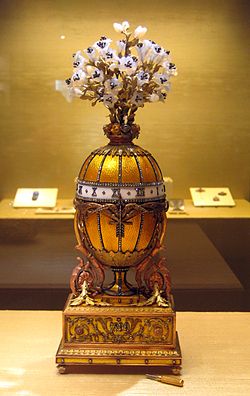 |
Art Nouveau enamel egg decorated with pearl lilies of the valley. The surprise is three medallions with portraits of the emperor and his two eldest daughters, Olga and Tatiana , extending upward . Master - Mikhail Perkhin . Art Nouveau style .It is said to be the Empress's favorite egg. | Kremlin Armoury, Moscow |
| 1899 | Pansy egg |  |
An egg made of solid jade on a golden leg made of bent leaves. The stems of five buds and flowers of pansies, decorated with stones, are raised to the egg. Surprise - an “easel” in the shape of a heart with medallions in the shape of opening strawberries - a family tree with portraits. | Matilda Gray Stream, US |
| 1900 | Trans-Siberian Railway egg |  |
A silver egg created to commemorate the construction and opening of the Trans-Siberian Railway . A map of the empire with a highway is stamped on the egg. The lid is decorated with enamel and surmounted by the imperial eagle. Stand made of silver (gilded) griffins on an onyx base.Surprise - a mechanical model of a train (a steam locomotive and 5 carriages). Jeweler - Mikhail Perkhin . | Kremlin Armoury, Moscow |
| 1900 | Cockerel egg |  |
Jeweler - Mikhail Perkhin . Enameled egg on a stand. Inside there is a clock mechanism.The surprise is a wind-up cockerel jumping out from under the openwork lid on top, capable of singing, opening its beak and flapping its wings | Viktor Vekselberg |
| 1901 | Basket of flowers |  |
The basket has an egg shape, an arched handle and a lush bouquet of flowers on a moss base (made of metal threads). The flowers are made of gold and painted with multi-colored enamel .The leg was lost and restored later.The surprise is lost or unknown. | Royal Collection, London, United Kingdom |
| 1901 | Gatchina Palace egg |  |
The egg is covered with enamel and divided by pearl stripes, decorated with hand-drawn patterns. Surprise - a copy of the main country residence of the Dowager Empress. Can't be removed.Jeweler - Mikhail Perkhin . | Walters Art Museum, Baltimore, Maryland |
| 1902 | Clover leaf egg |  |
Openwork egg in Art Nouveau style. The pattern is made up of clover leaves. Resting on a stand. Surprise lost, presumably portrait miniatures of the Grand Duchesses Alexandra Fedorovna Due to its fragility, it is very rarely moved or transported. One of the few eggs that did not leave Russian territory. | Kremlin Armoury, Moscow |
| 1902 | Empire nephrite egg |  |
Surprise – miniature portrait of Grand Duchess Olga Alexandrovna of Russia and Duke Peter Alexandrovich of Oldenburg (original lost) | Private collection, New York City |
| 1903 | Peter the Great egg | 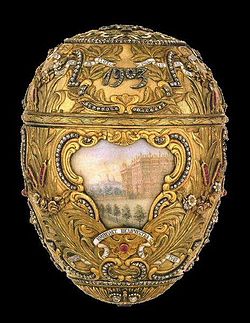 |
An egg in the Rococo style , dedicated to the 200th anniversary of St. Petersburg .Inside is a model of the Bronze Horseman on a sapphire stand. On the sides of the egg there are 4 miniatures with views of St. Petersburg. | Virginia Museum of Fine Arts, Richmond, Virginia, USA |
| 1903 | Royal Danish egg |  |
A gold, enamel egg supported by three lions is mounted on a pedestal. At the top is a royal elephant.
The surprise is a two-sided portrait of King Christian and Queen Louise , the parents of the Empress , in honor of the 40th anniversary of their accession to the throne.|| LOST | |
| 1904 | No known eggs made | |||
| 1905 | No known eggs made | |||
| 1899–1903 | Spring Flowers Egg |  |
This was among the effects of Maria Feodorovna inventoried in 1917; the basket was made in 1889 and the stand on/after 1902 (possibly given 1904 or 1905) | Viktor Vekselberg |
| 1906 | Moscow Kremlin egg |  |
The largest of the eggs. The Assumption Cathedral is depicted . The interior of the temple is visible through the windows. It is supported by the twice reproduced Spasskaya and Vodovzvodnaya towers of the Kremlin . The entire structure rests on an onyx pedestal.Inside there is a wind-up clock and a music box. | Kremlin Armoury, Moscow |
| 1906 | Swan egg |  |
A purple egg (the Empress’s favorite color) on rock crystal imitating the surface of water. It opens not evenly, but as if along a chip line.Surprise - a golden (silver-plated) swan in a basket on an aquamarine stand. Under the wing is a winding mechanism that powers the figure. | Edouard and Maurice Sandoz Foundation, Switzerland |
| 1907 | Rose trellis egg |  |
An enamel egg decorated with a lattice of diamonds; the cells contain rose buds and leaves. Jeweler - Henrik Wigström .The surprise was lost, presumably a medallion with a portrait of Tsarevich Alexei | Walters Art Museum, Baltimore, Maryland, USA |
| 1907 | Love trophies egg or 'Cradle with garlands' egg | An enamel egg decorated with a lattice of diamonds; the cells contain rose buds and leaves. Jeweler - Henrik Wigström .The surprise was lost, presumably a medallion with a portrait of Tsarevich Alexei | Private Collection | |
| 1908 | Alexander Palace egg |  |
Made of jade with miniatures of imperial children. The original stand is lost. Jeweler - Henrik Wigström .Surprise - a model of the Alexander Palace in Tsarskoe Selo. | Kremlin Armoury, Moscow |
| 1908 | Peacock egg | The crystal egg is set on a stand of twisted leaves and opens. Inside is a tree with a peacock. The miniature mechanical peacock can be removed from the branches and set in motion. Jeweler - Dorofeev.Inspired by the famous peacock clock in the Hermitage . | Edouard and Maurice Sandoz Foundation, Switzerland | |
| 1909 | Standart yacht egg |  |
Image of the yacht of Emperor Alexander III. Egg made of rock crystal and lapis lazuli on a dolphin stand. The yacht is made of gold, almost all parts are movable. Belonged to Alexandra Fedorovna | Kremlin Armoury, Moscow |
| 1909 | Alexander III commemorative egg |  |
Made entirely of platinum. Decorated with diamonds. The surprise is a miniature bust of Alexander III made of lapis lazuli . | LOST |
| 1910 | Colonnade egg |  |
An image of the temple of love in the form of a colonnade, inside there are a pair of doves, angels around the perimeter, and Cupid on top of the egg. Surprise - clockwork. Made in honor of the birth of the long-awaited heir . Cupid symbolizes Tsarevich Alexei , 4 cherubs symbolize the Tsarevich’s sisters. | Royal Collection, London, UK |
| 1910 | Alexander III equestrian egg |  |
Renaissance crystal egg on a stand of platinum angels. Inside is a golden model of the monument to the emperor by Paolo Trubetskoy. Belonged to Maria Fedorovna | Kremlin Armoury, Moscow |
| 1911 | Fifteenth anniversary egg |  |
The Golden Egg, divided into 16 sectors, each of which contains miniatures (7 portraits of family members and 9 scenes of the reign, including the coronation, the opening of museums and monuments, the discovery of the relics of Seraphim of Sarov ). Jeweler - Henrik Wigström .Belonged to Alexandra Fedorovna | Viktor Vekselberg |
| 1911 | Bay tree egg | 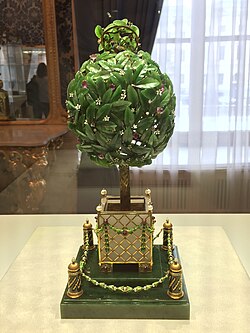 |
Also known as the Orange Tree Egg,The egg is formed from tangled branches of a tree decorated with stones. Below there is a semblance of a tub and a fence. Inside is a wind-up bird, acting like the cockerel in the egg of the same name. Belonged to Maria Fedorovna. | Viktor Vekselberg |
| 1912 | Tsarevich egg |  |
The Louis XV style egg is made from a single shard of lapis lazuli and decorated with gold patterns. The surprise is a diamond double-headed eagle with a miniature portrait of Tsarevich Alexei (presumably a copy of a lost miniature). Belonged to Alexandra Fedorovna | Virginia Museum of Fine Arts, Richmond, Virginia |
| 1912 | Napoleonic egg |  |
To the 100th anniversary of the Patriotic War. The surprise is a screen with 6 miniatures depicting representatives of the regiments of which the Empress was an honorary colonel.Belonged to Maria Fedorovna | Matilda Geddings Gray Foundation. Displayed at the Metropolitan Museum of Art, New York. |
| 1913 | Romanov tercentenary egg | 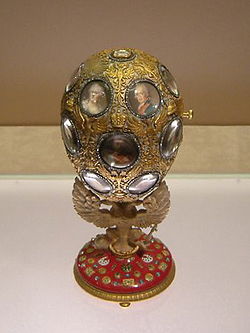 |
Enamel egg with miniatures of Russian rulers. Supported by a gilded silver eagle standing on a "shield". Inside is a steel globe with the territory of the Russian Empire marked in 1613 and 1913. Belonged to Alexandra Fedorovna | Kremlin Armoury, Moscow |
| 1913 | Winter egg | Transparent egg made of crystal , platinum and diamonds . Located on a crystal stand imitating melting ice. Surprise - platinum wicker basket with quartz snowdrops . Designer: Alma Pihl.Belonged to Maria Fedorovna . | The State of Qatar | |
| 1914 | Mosaic egg |  |
The platinum mesh along the perimeter is studded with precious stones. Divided into ovals. At the top is a moonstone.The surprise is a cameo on a stand with profiles of children. Designer: Alma Pihl . Jeweler Albert Holström. The last egg without budget restrictions. Belonged to Alexandra Fedorovna | Royal Collection, London, UK |
| 1914 | Grisaille egg or Catherine the Great egg |  |
The egg was made by Henrik Wigström, Fabergé's last head workmaster. It was given to Maria Fedrovna by her son Nicholas II. Its surprise (now lost) was "a mechanical sedan chair, carried by two blackamoors, with Catherine the Great seated inside".[8] | Hillwood Museum, Washington, D.C., USA |
| 1915 | Red Cross with triptych egg |  |
Folding egg, similar in design to the Red Cross with imperial portraits . On the sides of the egg are portraits of the Grand Duchesses Olga and Tatiana. Inside is an image of the Descent into Hell with the image of Saints Olga and Tatiana. Belonged to Alexandria Fedorovna | Cleveland Museum of Art, Cleveland, Ohio, USA |
| 1915 | Red Cross with imperial portraits |  |
A white silver egg with a red cross in the middle. Surprise - 5 portraits of women close to the emperor: two daughters, a sister, a wife and a cousin in the uniform of nurses.Belonged to Maria Fedorovna. | Virginia Museum of Fine Arts, Richmond, Virginia |
| 1916 | Steel military egg |  |
Steel egg with superimposed gold crests and crown. Stands on four bullets and a jade pedestal. Surprise - miniature: visit of the emperor and heir to the troops. The lack of luxury is a result of wartime. The last one received by Empress Alexandra . Perhaps the shiny polishing of the steel was done during Soviet times to prevent rust from appearing . | Kremlin Armoury, Moscow |
| 1916 | Order of St. George egg |  |
Made during World War I, the egg commemorates the Order of St. George awarded to Emperor Nicholas and his son, the Grand Duke Alexei Nikolaievich.[9] This and the previous egg were given a modest design in keeping with the austerity of World War I.[10] Fabergé billed 13,347 rubles for the two.[9] The Order of St. George egg left Bolshevik Russia with its original recipient, the Dowager Empress Maria Feodorovna.[11] | Viktor Vekselberg |
| 1917 | Twilight/Night egg | The Twilight Jewelry Easter Egg is made of gold , diamonds and moonstone , decorated with a dark blue lapis lazuli mosaic depicting the evening sky. A golden gate is made on the front surface of the jewelry; if it is open, you can see the engraved garden of Peterhof . The reverse side of the Easter egg is decorated with a double-headed eagle - the coat of arms of the Romanov house, above which the date is carved: “1917”; if there was a surprise it was lost;Since 1923 it belonged to Mrs. Lin ( Harbin , China ). In 1976, Ms. Lin's collection was sold in Geneva at Christie's . The Twilight Jewelry Easter Egg was purchased by Mr. Attinger, Zurich , Switzerland , acting as a private buyer's agent | Private Collection | |
| 1917 | Karelian birch egg | Made in 1917, the egg was due to be completed and delivered to the tsar that Easter, as a present for his mother, the Empress Maria Feodorovna. Before the egg could be delivered, the February Revolution took place and Nicholas II was forced to abdicate on March 15. On April 25, Fabergé sent the Tsar an invoice for the egg, addressing Nicholas II not as "Tsar of all the Russians" but as "Mr. Romanov, Nikolai Aleksandrovich". Nicholas paid 12,500 rubles. The egg was sent to Grand Duke Michael Alexandrovich at his palace, for presentation to the empress, but the duke fled before it arrived. The egg remained in the palace until it was looted after the October Revolution. The suprise was a miniature mechanical elephant, covered with tiny rose-cut diamonds, wound with a small jewel-encrusted key; the surprise was lost although the key survives | Alexander Ivanov. Displayed at Ivanov's Fabergé Museum in Baden-Baden, Germany. | |
| 1917 | Constellation egg |   |
Not finished and not decorated. There are no precious stones. The egg was supposed to be made of blue glass with an engraving - the zodiac constellation of the crown prince ( the constellation Leo ), encrusted with diamonds. Frosted crystal stand in the shape of clouds and supporting silver cupids. There is a clock inside. Cupids, diamond inlay and watches were not made or preserved. Because of the Russian Revolution, this egg was never finished or presented to Tsar Nicholas's wife, the Tsaritsa Alexandra Feodorovna. Two eggs have claims to be the Constellation egg: one held at Fersman Mineralogical Museum in Moscow and the other in the possession of Alexander Ivanov and displayed at Ivanov's Fabergé Museum in Baden-Baden, Germany. | Fersman Mineralogical Museum, Moscow or the Fabergé Museum in Baden-Baden. |
List of the Kelch eggs
Faberge also made eggs for Alexander Kelch, a Siberian gold mine industrialist, as gifts for his wife Barbara (Varvara) Kelch-Bazanova. Most are copies of other eggs.
| Date | Egg | Image | Description | Owner |
|---|---|---|---|---|
| 1898 | Kelch Hen Egg |  |
Viktor Vekselberg | |
| 1899 | Twelve Panel Egg | Royal Collection, London, UK | ||
| 1900 | Pine Cone Egg | Private collection | ||
| 1901 | Apple Blossom Egg |  |
Liechtenstein National Museum | |
| 1902 | Rocaille Egg | 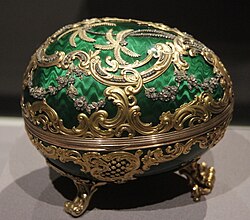 |
Dorothy and Artie McFerrin collection | |
| 1903 | Bonbonnière Egg | Private collection | ||
| 1904 | Kelch Chanticleer Egg |  |
Viktor Vekselberg |
Other Fabergé eggs
| Date | Egg | Image | Description | Owner |
|---|---|---|---|---|
| 1885–91 | Blue Striped Enamel Egg | Private collection | ||
| 1902 | Duchess of Marlborough Egg |  |
Viktor Vekselberg | |
| 1902 | Rothschild Egg |  |
Hermitage Museum, Saint Petersburg, Russia | |
| 1907 | Youssoupov Egg | Edouard and Maurice Sandoz Foundation, Switzerland | ||
| 1914 | Nobel Ice Egg | 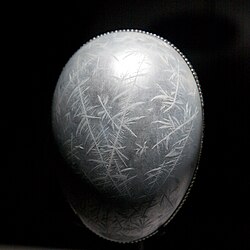 |
Dorothy and Artie McFerrin collection | |
| 1885–89 | Resurrection Egg |  |
possibly the surprise from the 1894 Renaissance Egg[12] | Viktor Vekselberg |
| 1899–1903 | Scandinavian Egg |  |
Viktor Vekselberg | |
| 1895 | Egg-Stamp | A seal, made of red gold, surrounding the upper part of the Egg and bowenite, decorated with 19 diamonds. At the top of the Egg six rubies, cabochons on garlands, and three rubies, cabochons on the chest of the cherubs. | Private collection |
Fabergé Egg Media
The Imperial Coronation egg, one of the most famous and iconic of all the Fabergé eggs
References
| Wikimedia Commons has media related to Lua error in Module:Commons_link at line 62: attempt to index field 'wikibase' (a nil value).. |
- ↑ "Faberge Egg, In Classic Style, History, Easter Egg, James Bond | In Classic Style". Archived from the original on 2012-06-25. Retrieved 2015-09-30.
- ↑ "A Fabergé egg is not just for Easter". 23 March 2008. Retrieved 10 September 2019 – via www.telegraph.co.uk.
- ↑ Egg Week: The story behind the world's largest and most expensive Easter egg hunt | National Post
- ↑ "The Third Imperial Faberge Easter Egg at Wartski". Archived from the original on 2014-07-04. Retrieved 2015-09-30.
- ↑ Singh, Anita (18 March 2014). The £20m Fabergé egg that was almost sold for scrap. https://www.telegraph.co.uk/culture/art/art-news/10706025/The-20m-Faberge-egg-that-was-almost-sold-for-scrap.html. Retrieved 19 March 2014.
- ↑ Housed in the Metropolitan Museum of Art in New York City, New York, planned to be till 2016. "Fabergé from the Matilda Geddings Gray Foundation Collection November 22, 2011–November 27, 2016". Museum of Modern Art. Retrieved 2015-09-05.
- ↑ Hillwood Museum have identified the twelve monograms Egg previously dated to 1895 as the Alexander III portraits egg of 1896, [1] Archived 2014-04-16 at the Wayback Machine
- ↑ "Hillwood Estate, Museum & Gardens - The Catherine the Great Egg". hillwoodmuseum.org. Archived from the original on 4 December 2013. Retrieved 10 September 2019.
- ↑ 9.0 9.1 "Faberge - Treasures of Imperial Russia". Archived from the original on 2007-07-28. Retrieved 2015-09-30.
- ↑ "Mieks Fabergé". August 2013. Archived from the original on 2015-04-23. Retrieved 2015-09-30.
- ↑ "Faberge". Treasures of Imperial Russia. Archived from the original on 2007-07-28. Retrieved 2012-03-26.
- ↑ "Faberge - Treasures of Imperial Russia". 21 September 2013. Archived from the original on 2013-09-21. Retrieved 10 September 2019.